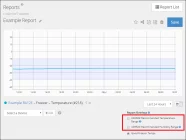Installing Warehouse Temperature and Humidity Monitoring Solutions
Fulfilment and warehouse distribution centres are critical to the successful operation of any ecommerce and distribution-based business. Computer and automation systems play a vital role to such organisations, with most having temperature, humidity and water leakage monitoring system within their server rooms or data centres. It can be as important to extend these monitoring systems to include the stores and distribution areas within their supply chains. Failure to monitor warehouses can lead to unexpected disruption to operations and losses in the form of damage to stock and inventory caused by poor temperature controls, a build-up of humidity and water leakage.
Automated Smart Warehouse Temperature and Humidity Controls
From a temperature-controlled environment point of view warehouses can be one of the following types:
- Ambient temperature controlled: reliant on the natural temperature with some fan assisted cooling as external temperatures rise
- Air-conditioned: 13-25⁰C / 56-75°F using air conditioning and additional dehumidifiers as required
- Refrigerated: 0.5-12⁰C / 33–55°F using air conditioning and refrigerant cooling systems
- Cold-storage: below 0⁰C / 32⁰F using refrigerant cooling systems
Automated or smart warehouses use the latest management systems, picking tools, guided vehicles, inventory controls, robotics and IoT systems to monitor and control ever aspect of their operation. They tend to be the air-conditioned type for general for general goods distribution, refrigerated for food distribution and cold storage for pharmaceuticals. Food and pharmaceutical warehouses and supply chains tend to be subject to greater regulations and inspections. Records of environmental performance must be maintained with suitable monitoring systems in place.
Humidity and Temperature Monitoring
For most warehouses, temperature control and monitoring can be mandatory. Food and pharmaceutical industries are prime examples. Temperature and humidity levels must be maintained and often this is achieved through local air conditioning systems. These may be installed as N+1 systems, to allow for duty cycling and maintenance. Where there is no resilience a sudden air conditioner failure or under performance can lead to a large swing in temperature and the spoiling of stock within the warehouse.
An air conditioning system will also help to control humidity within a warehouse. Sometimes however, humidity can build-up in areas with poor air flow, or where there is a high background water content in the air. As the humidity rises, so does the opportunity for mildew and mould growth, which can lead to rust and metal corrosion on storage racking, cabling, and other exposed parts of a warehouse system. Once the product packaging is damaged (wooden crates and cardboard packing), the stock can be unsellable and must be disposed of, leading to an insurance claim and potential profit loss.
Distribution centres by default tend to operate 24/7 and this can lead to changes in operational warehouse temperatures and humidity during a 24hour period. Relative Humidity (RH) for example can be within a 30% range during the working day but rise to 70% or greater at night as outside temperatures drop.
With high humidity, there is a greater potential for mould growth. Mould can be damaging not only to product packaging but the health of warehouse workers, especially in enclosed spaces within the warehouse and this can lead to respiratory related illness, time of work and potential liability claims. Once there is mould within any physical space, it can be difficult to eliminate, without a deep-clean which will require the distribution centre to be shutdown for a period. The principle purpose of the deep-clean being to remove microscopic mould spores. Mould tends to thrive in warmer temperatures, in air with higher water content. Colder temperatures (including fridges and freezers) can help to reduce the opportunity for mould growth but even here, once there are spores present in the air, it can be difficult to maintain the integrity of the stock and the environment.
Temperature and humidity monitoring are the two principle fundamentals of an environmental monitoring system. The right monitoring device, with suitably deployed temperature and humidity sensors can monitor for changes to temperature and humidity and issues alerts to pre-set distribution lists when variances occur. These alerts can be via email, SMS, voice phone calls and digital alarms to third-party systems and monitoring platforms.
In addition, it is important to correctly size the air conditioning system to be used in a warehouse. Under and oversizing can lead to poor system performance. The AC unit should be set to operate in ‘auto-mode’ where it will constantly adjust for temperature and humidity levels. Most ac systems also include an alarm interface which can also be connected to an environmental monitoring system and/or a local IP network for SNMP or MODBUS protocol monitoring.
Sensors and Detectors for Air-Conditioned Warehouses
Additional sensors that can be connected to an environmental monitoring system, specifically for air conditioner system performance monitoring include:
- Airflow Sensors: can be placed near to an air conditioner’s output vents to monitor airflow speeds and generate a signal contact (normally open or normally closed) if the airflow changes or stops.
- Differential Air Pressure Sensors: monitoring air pressure can also be important in a warehouse setting. In hotter and more humid environments, it can be important to maintain a slightly positively pressured building. This helps to prevent outside warm and humid air from entering the warehouse. Even with closed warehouse doors and minimal windows, warm/humid air can be drawn into a building through wall cavities, poorly joined window and joining surfaces, leading to mildew and mould growth in hard to get to and hidden areas.
- Power Monitoring Detectors: in a distribution environment, essential electrical systems may have generator backup in case of a power outage. Where this is not the case, power monitoring can detect a power failure and issue an alarm message.
- Water Leakage Detectors: faulty and poorly maintained air conditioners can leak cooling fluid and water. Drip trays can help to collate this and drain-off. Where they are not installed, water can pool beneath, potentially falling onto other electrical systems or stock. Spot water leakage detectors or water leakage detection ropes can be connected to environmental monitoring systems to issue automatic alarms.
When specifying an environmental monitoring system, it is important to define the sensor and detector numbers required. This will help to define the number of monitoring ports and environmental monitoring base units required. The smallest monitoring base unit may have one or two ports, whilst larger systems can have 8-16 or more.
Fixed Wired or Wireless Monitoring Systems
Fixed wired sensors plug onto the sensor ports on an environmental monitoring unit base station. Sensors can sometimes be ‘daisy chained’ together on the same IP network allowing for longer distances. The standard cable lengths typically available off-the-shelf include 1m, 3m, 7.5m and 15m with custom lengths available to order up to 30m or more up to a practical maximum length of 100m.
Hardwired cable sensors and detectors are not always practical or cost-effective. In this instance ‘wireless’ installation is an option. A wireless environmental monitoring system can be easier to install and maintain. Its measurement information and recording will be as accurate as from a hardwired installation. A LoRa-based wireless system consists of a gateway sensor tunnel to which sensors are connected and then monitored over the ACKPro Software platform. Battery backed-up to protect from power outages, with a 10year design life battery, a wireless monitoring system is easy to deploy and can be idea, especially in automated smart warehouse applications.
Summary
Extending a server room or data centre environmental monitoring system into warehouse environments can provide a single pane-of-glass view of the mission critical areas operated by a distribution business in terms of temperature and humidity control. A remote humidity and temperature monitoring software management package can provide real time measurements and status updates, with alarm distribution lists setup for each area. Options such as wireless sensors and gateways, in addition to fixed 19inch rackmount monitoring base units and hardwired sensors, can lead to a more cost-effective and easier to scale system that can meet future needs and requirements as the business expands. For more information on warehouse temperature monitoring please contact our projects team.


























